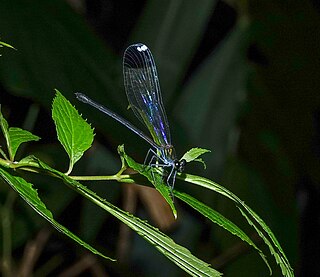Related Research Articles
Novosphingobium is a genus of Gram-negative bacteria that includes N. taihuense, which can degrade aromatic compounds such as phenol, aniline, nitrobenzene and phenanthrene. The species N. aromativorans, which was first found in Ulsan Bay, similarly degrades aromatic molecules of two to five rings.
Nitrospirota is a phylum of bacteria. It includes multiple genera, such as Nitrospira, the largest. The first member of this phylum, Nitrospira marina, was discovered in 1985. The second member, Nitrospira moscoviensis, was discovered in 1995.

Echo is a genus of damselflies belonging to the family Calopterygidae. There are five species. A sixth, Echo maxima, is sometimes included, but it probably belongs to a different genus.
Jeotgalicoccus marinus is a species of Gram-positive, facultatively anaerobic bacteria. It is moderately halophilic, it grows in environments with 0.5–25.0 % total salts. The cells are coccoid. The species was isolated from a sea urchin from the South China Sea.
Majiashanosaurus is an extinct genus of pachypleurosaur or alternatively a basal eosauropterygian known from the Early Triassic of Anhui Province, eastern China. It contains a single species, Majiashanosaurus discocoracoidis.
Chryseobacterium flavum is a Gram-negative, rod-shaped and non-motile bacteria from the genus Chryseobacterium which has been isolated from polluted soil in the Jiangsu Province in China.
Microbacterium flavum is a Gram-positive and aerobic bacterium from the genus Microbacterium which has been isolated from the tunicate Didemnum moseley in Nagasaki, Japan.
Laceyella is a Gram-positive, thermophilic, spore-forming and aerobic bacterial genus from the family of Thermoactinomycetaceae. The genus Laceyella is namened after the English microbiologist John Lacey.
Pontibacter is a strictly aerobic bacterial genus from the family Hymenobacteraceae.
Aeromicrobium is a Gram-positive, aerobic, non-spore-forming and non-motile bacterial genus from the family of Nocardioidaceae.
Aeromicrobium flavum is a Gram-positive facultatively anaerobic and non-motile bacterium from the genus Aeromicrobium which has been isolated from air from the Wuhan University campus in China.
Roseomonas is a genus of Gram negative bacteria. The cells are coccoid rods when viewed microscopically. Certain species are known to be opportunistic infections for humans.
Ornithinimicrobium flavum is a Gram-positive, non-spore-forming and non-motile bacterium species from the genus Ornithinimicrobium which has been isolated from a leaf of the plant Paris polyphylla var. yunnanensis.
Halodurantibacterium is a Gram-negative genus of bacteria from the family of Rhodobacteraceae with one known species. Halodurantibacterium flavum has been isolated from an oil production mixture from the Daqing Oilfield in China.
Cryobacterium flavum is a Gram-positive and rod-shaped bacterium from the genus Cryobacterium which has been isolated from glacier ice from Xinjiang in China.
Edaphobaculum is a Gram-negative, strictly aerobic, rod-shaped and non-motile genus of bacteria from the family of Chitinophagaceae with one known species. Edaphobaculum flavum has been isolated from grassland soil from Erdos in China.
Antribacter gilvus is a Gram-positive, aerobic and non-motile species from the family Promicromonosporaceae.
Salinimicrobium flavum is a Gram-negative, facultatively anaerobic and rod-shaped bacterium from the genus of Salinimicrobium which has been isolated from marine sediments from the coast of Weihai.
Antarcticibacterium flavum is a Gram-negative, strictly aerobic and rod-shaped bacterium from the genus of Antarcticibacterium which has been isolated from sediments from the Ross Sea. The whole genome of Antarcticibacterium flavum is sequenced.
Aureibaculum marinum is a Gram-negative, aerobic and non-motile bacterium from the genus of Aureibaculum which has been isolated from marine sediments from the Bohai Gulf.
References
- 1 2 "Species: Aureibaculum flavum". LPSN.DSMZ.de.
- 1 2 He, Xiao-yan; Liu, Ning-hua; Lin, Chao-yi; Sun, Mei-ling; Chen, Xiu-lan; Zhang, Yu-zhong; Zhang, Yu-qiang; Zhang, Xi-ying (13 January 2022). "Description of Aureibaculum luteum sp. nov. and Aureibaculum flavum sp. nov. isolated from Antarctic intertidal sediments". Antonie van Leeuwenhoek. 115 (3): 391–405. doi:10.1007/s10482-021-01702-8. PMID 35022928. S2CID 245946623.